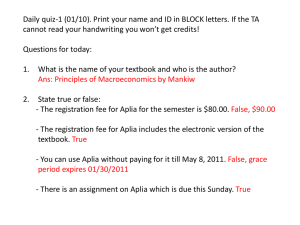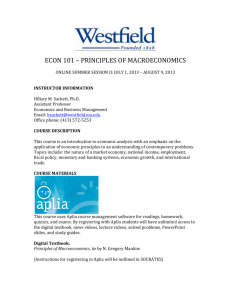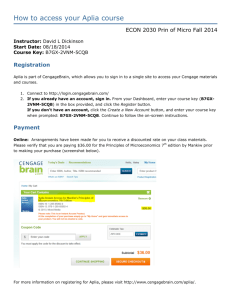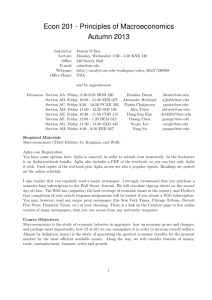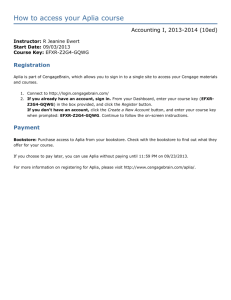BOSTON COLLEGE Department of Economics EC 2202 Macroeconomic Theory Spring 2016
advertisement
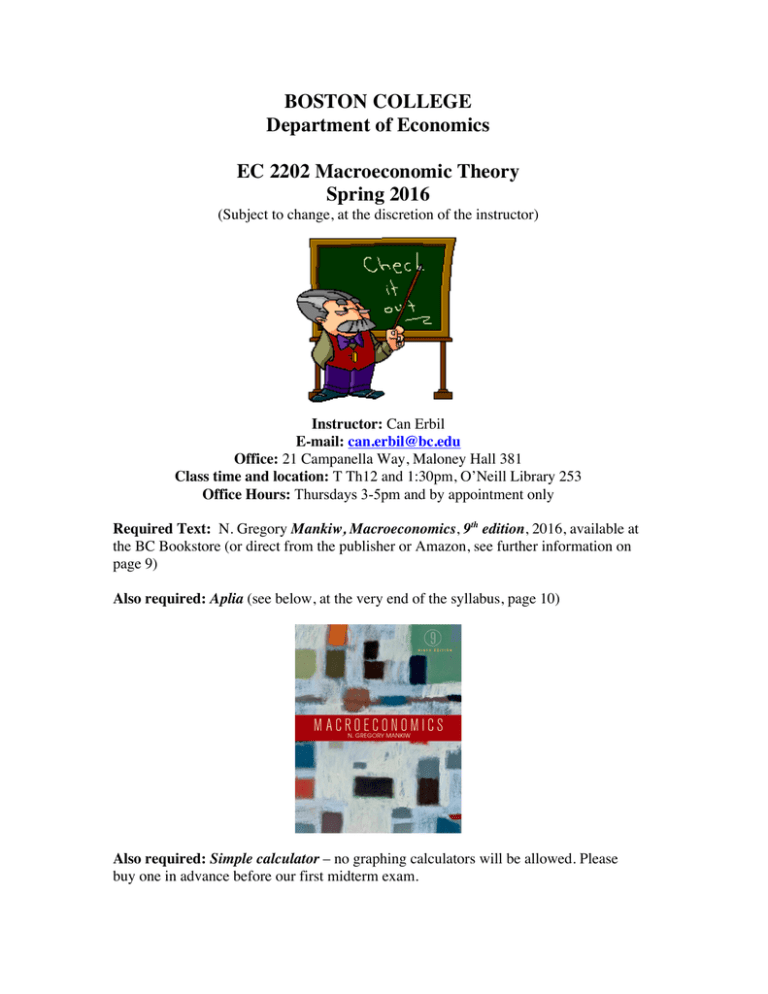
BOSTON COLLEGE Department of Economics EC 2202 Macroeconomic Theory Spring 2016 (Subject to change, at the discretion of the instructor) Instructor: Can Erbil E-mail: can.erbil@bc.edu Office: 21 Campanella Way, Maloney Hall 381 Class time and location: T Th12 and 1:30pm, O’Neill Library 253 Office Hours: Thursdays 3-5pm and by appointment only Required Text: N. Gregory Mankiw, Macroeconomics, 9th edition, 2016, available at the BC Bookstore (or direct from the publisher or Amazon, see further information on page 9) Also required: Aplia (see below, at the very end of the syllabus, page 10) Also required: Simple calculator – no graphing calculators will be allowed. Please buy one in advance before our first midterm exam. [PLEASE NOTE THAT: ATTENDANCE IS MANDATORY FOR THIS COURSE AND EACH STUDENT IS EXPECTED TO ATTEND THE SECTION HE/SHE IS REGISTERED IN]. Course Overview: This course provides an introduction to the modern theory and practice of macroeconomics. It covers a variety of classic questions in macroeconomics including: What are the determinants of long-run economic growth? Why do economies regularly experience booms and recessions? Why is there unemployment? What determines the value of money in an economy? The course focuses particular attention on how macroeconomic policy (monetary and fiscal) affects outcomes in these dimensions, and on using the tools of the field to evaluate alternative policy responses to current events. The total amount of reading in this course is modest, but the prudent student will read it several times. I highly recommend that you read the material assigned before we discuss it in class, and then read it again afterwards. The course material is cumulative, with each topic building on prior ones, so missing classes and falling behind are particularly bad ideas. Supplements and Current Economic News: I will also post a set of supplements for the course, prepared by Prof. Bob Murphy, on our BB Vista. These Supplements will often go into more depth than the textbook or highlight issues not directly covered in the text. As time allows, we will discuss some of these in class, but most of them are for your own enjoyment. I also encourage you to follow current economic issues by reading on a daily basis one of the major national newspapers (e.g., The Wall Street Journal, The New York Times, and The Washington Post). Fortune, Business Week and the Economist magazines also are good sources for keeping up on economic events. We will frequently discuss the current state of the economy and current policy debates in class, and homework and exams are likely to ask you for an informed discussion of current events. I will post articles of interest to you on our Canvas Website. If you see something related to one of our topics, send it to me, and I may pass it on to your classmates. I encourage discussion in class by asking you questions, which I urge you to think about and answer. I also encourage you to ask questions in class, especially when you are confused. If you are confused, so are many of your classmates. Do us all a favor, and speak up! I take attendance and class participation will determine part of your grade (see below). I urge you to study this material together. You can learn as much from each other as you can from the textbook or from class. 2 Prerequisites: Principles of Microeconomics (EC1131) Principles of Macroeconomics (EC1132) One semester of calculus (MT100 or MT102) To enjoy this class you must be able and willing to deal with a few technicalities. You should be familiar with these tools in advance. Problem Sets: I will assign problem sets from Aplia. Some of these will be graded, and some problem sets will be for practice only. I may post additional problem sets from the “end-of-chapter” questions of Mankiw’s textbook on BB Vista. These problem sets are to be handed in during class on the due dates. I urge you to work through these problems and check the answer keys. You may work together on the problem sets. You may work in groups, but each student must turn in her or his own work. Aplia does not accept late homework. Grading: Attendance & Class Participation: Problem Sets (Aplia): Exam#1 Exam#2 Exam#3 Policy Analysis/Case Study: Group Presentation: [TBA] [TBA] [TBA] [TBA] [TBA] 15% 10% 20% 20% 20% 10% 5% All exams will be in our classroom, during regular class time. Dates are to be determined. The examinations will be a combination of multiple-choice questions, “true or false” questions, graphical and numerical problems, and short essays. If you have to miss a midterm, please let me know as soon as you know it. Please note that I can only use my discretion to excuse you from the exam, when I receive formal notification from your dean about your case. There will be NO make-up exams; if you miss an exam, the weights on your subsequent exams will be increased proportionately. Any unverified absence from an exam will result in a zero score for that exam. 3 Policy Analysis/Case Study: The policy analysis assignment will be due on the last week of the course. This assignment will allow you to chose a current event and analyze it with the macro tools and models we developed in class during the semester. It is a short analysis (3-4 pages, 1.5 space, font size 12) with a focus macroeconomic policy. It will mimic our group presentations, but this time it is solo. You can pick any topic we covered in class. i) Please find an article related to Macroeconomics [The choice of your source (your article) is very important. It has to be directly related to what we covered in class and macro theory. Investment, stock market analysis, financial analysis pieces, op-eds or blogs from financial market analysts are not good choices. Going over sources like the Economist, WSJ, New York Times, FT, etc... will give you many options.] ii) Connect it to the material we covered in class, using equations, graphs and our models. Utilizing at least one interactive graph is required. [This is the most important task, along with the choice of your source. These two will shape your grade. Definitely include at least one graphical analysis.] iii) Put your draft presentation together in a short analysis format (3-4 pages, 1.5 space, font size 12) - similar to the articles you used in your group presentation. Group Presentation: Groups will consist of five students each. I will assign a different topic to each group during the semester. Each group will have one week to prepare a brief presentation before the class. Presentations will be in power point or a similar media format. Each presentation will be 10-15 minutes max (2-3 minutes per student). Below is a guideline for presenters: 1) Please find an article related to [monetary policy - or whatever your assigned subject it] [The choice of your source (your article) is very important. It has to be directly related to what we covered in class and macro theory. Investment, stock market analysis, financial analysis pieces, op-eds or blogs from financial market analysts are not good choices. Sources like the Economist, WSJ, New York Times, FT, etc... will give you many options.] 2) Try to connect it to the material we covered in class, preferably using equations, graphs and our models. 4 [This is the most important task, along with the choice of your source. These two will shape your grade.] 3) Put your draft presentation together in a PPT format (10-15 slides max). 4) Send your draft PPT to me along with the original article; at least 3 days before your presentation so I can provide you with some feedback - this will give you enough time to make changes if necessary. 5) Please make sure to practice together at least once before presenting in front of the class - the group will get a grade only as good as the weakest member, so please help each other to make this right. You can start communicating via e-mail. 6) I expect the presentation to be smooth, quick and clear. 7) If you want, you can record your practice and send it to me for my comments This is only 1-2 minutes (1-2 slides) per person, I am sure you can put together an excellent presentation. Below is a guideline for graders: 1) Everybody who is not part of the presenting group will be grading [1-10, 1 lowest, 10 highest grade] 2) For each presentation, I want you to submit these grades (via e-mail, to me, by the end of the presentation day): i) The choice of article (interesting, relevant, up-to-date, source) [1-10] ii) How well it was connected to the class material [1-10] iii) Overall presentation for the entire group (clear and smooth) [1-10] 3) In addition, you will also grade each presenter on his or her presentation skills [1-10] x 5 Information Dissemination: All lecture notes; homework assignments, project instructions, as well as some supplementary material will be available on Canvas. Please check Canvas frequently as the additional problem sets, answer keys, notes, announcements and more will be posted there (as .pdf) and will be available for you to download/access. In addition, Worth Publishers has a web site that accompanies the textbook (http://bcs.worthpublishers.com/mankiw8) where you will find some useful materials. 5 If you need to submit your homework electronically, please do so by email before the beginning of class on the due date. The best way to reach me is via e-mail (can.erbil@bc.edu). Please don’t leave any voice messages on my office phone, since I don’t check them on a regular basis. If you cannot make my scheduled office hours, and would like to set up an appointment to see me, please send me your academic schedule (courses you are taking, their meeting times and professors, and classroom locations) and I will try to find time for you. Academic Integrity, Disability Services: Any infraction of Boston College’s Academic Integrity Policy (available online at http://www.bc.edu/offices/stserv/academic/resources/policy.html#integrity) will result in an automatic F for the course and the offense will be reported to the Dean’s office. There will be no exceptions. Boston College is committed to providing equal and integrated access for students with disabilities to all available academic, social, and recreational programs and activities. The Disability Services Office at Boston College ensures that students with disabilities receive appropriate accommodations and assistance in order to participate fully in University programs. Students requiring assistance are advised to get in touch with the Office of the Dean for Student Development (on the web at http://www.bc.edu/offices/odsd/disabilityservices.html). Optimizing Your Performance: Here are some suggestions that may help you to have the best chance to do well in my class: 1) Attend the lecture. The purpose of the course is to teach you something, not to toss out information and see how much sinks in. 2) Do the assigned readings before class to get a preview of the material to be covered and to prepare any questions you have about this material. Study the material, don’t just read it. 3) Check our course website regularly. I will update it weekly to indicate our progress on the outline. 4) Take the problem sets seriously, because they are the best indication of whether you understand the material and they are the best preparation for the exams. 5) When preparing for exams, let the lectures guide you as to what is really important. 6 6) And by all means, seek help if you need it, and before you get hopelessly behind. Flu: If you develop flu symptoms, do not go to class. Try to keep up with class assignments using the materials available on BB Vista and notify your dean and me. For more information please refer to the H1N1 Academic Protocols for Faculty and Students at http://www.bc.edu/offices/uhs/education/H1N1_flu.html. Course Outline (Preliminary and subject to change at the instructors discretion) (1st and 2nd week) Part I: Introduction 1.The Science of Macroeconomics (summary) 2. The Data of Macroeconomics (summary) Part II: Classical Theory: The Economy in the Long Run 3. National Income: Where It Comes From and Where It Goes (3rd-6th weeks) Part II: Classical Theory: The Economy in the Long Run ( continued) 4. The Monetary System: What It Is, and How It Works 5. Inflation: Its Causes, Effects, and Social Costs 6. The Open Economy 7. Unemployment and the Labor Market 7 (7th week) Part III: Growth Theory: The Economy in the Very Long Run 8. Economic Growth I: Capital Accumulation and Population Growth 9. Economic Growth II: Technology, Empirics, and Policy (8th-12th weeks) Part IV: Business Cycle Theory: The Economy in the Short Run 10. Introduction to Economic Fluctuations 11. Aggregate Demand I: Building the IS-LM Model 12. Aggregate Demand II: Applying the IS-LM Model 13. The Open Economy Revisited: The Mundell-Fleming Model and the Exchange Rate Regime 14. Aggregate Supply and the Short-run Tradeoff Between Inflation and Unemployment 15. A Dynamic Model of Economic Fluctuations (optional) (13th week) - OPTIONAL Part VI: Topics in Macroeconomic Policy 18. Alternative Perspectives on Stabilization Policy 19. Government Debt and Budget Deficits 20. The Financial System: Opportunities and Dangers (covered during the semester, built in several chapter) 8 Purchasing options for the course textbook and Aplia package: For other purchasing options, check out: http://www.macmillanhighered.com/Catalog/pr oduct/macroeconomics-­‐ninthedition-­‐ mankiw/valueoptions -­‐ tab 9 How to access your Aplia course EC 2202 - Macroeconomic Theory – Spring 2016 Instructor: Can Erbil Start Date: 01/19/2016 What is Aplia? In just 10 years, more than one billion answers have been submitted through Aplia, the premier online assignment solution. Millions of students use Aplia to better prepare for class and for their exams. Join them today! Registration 1. Connect to http://login.cengagebrain.com/course/UCRS-2CND-USAG 2. Follow the prompts to register for your Aplia course. Payment After registering for your course, you will need to pay for access using one of the options below: Online: You can pay online using a credit or debit card, or PayPal. Bookstore: You may be able to purchase access to Aplia at your bookstore. Check with the bookstore to find out what they offer for your course. Free Trial: You can access Aplia until 11:59 PM on 02/08/2016 during your free trial. After the free trial ends you will be required to pay for access. Please note: At the end of the free trial period, your course access will be suspended until your payment has been made. All your scores and course activity will be saved and will be available to you after you pay for access. If you already registered an access code or bought Aplia online, the course key to register for this course is: UCRS-2CND-USAG System Check To check whether your computer meets the requirements for using Aplia, go to http://www.aplia.com/support/config.jsp 10
